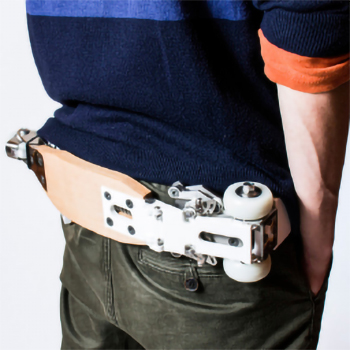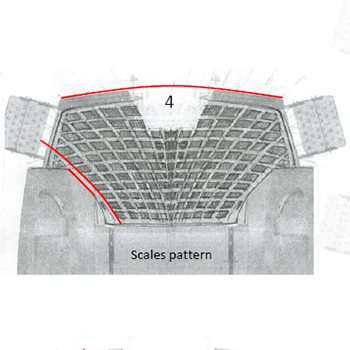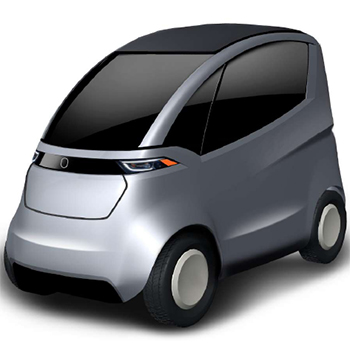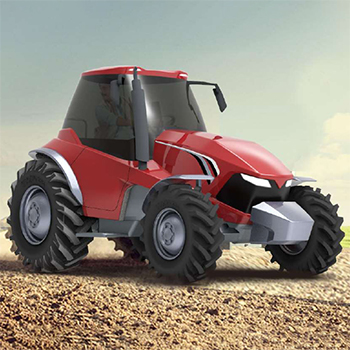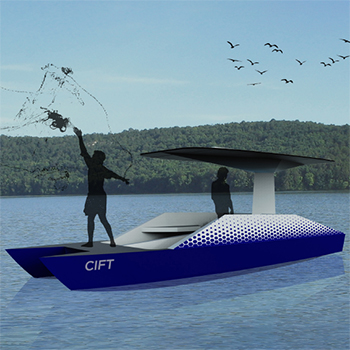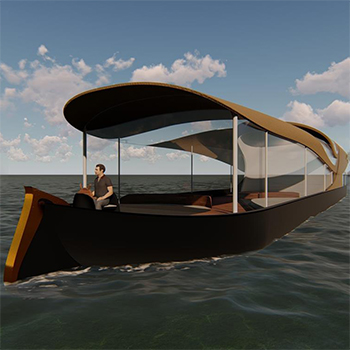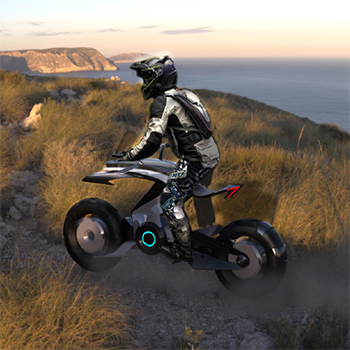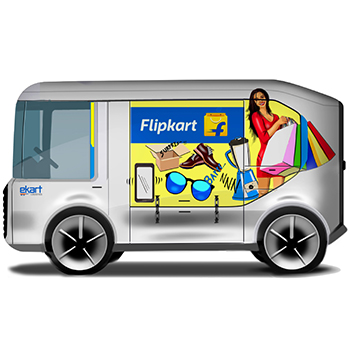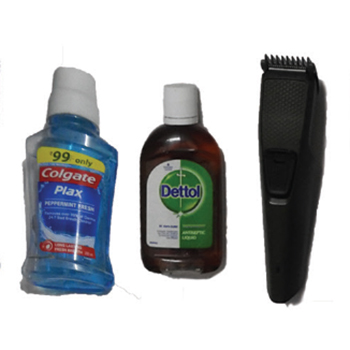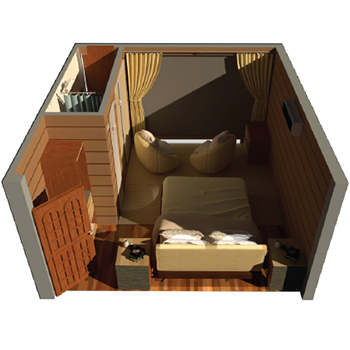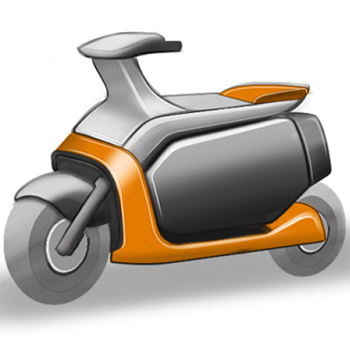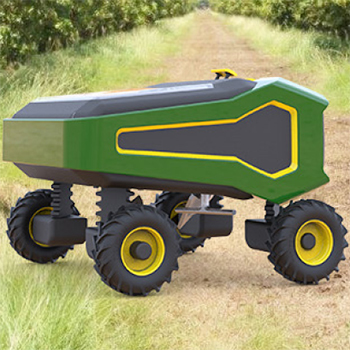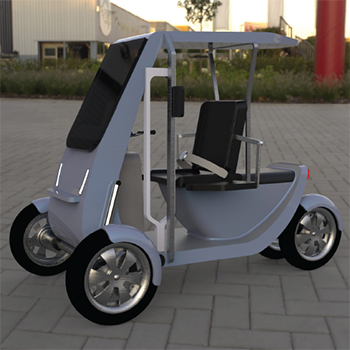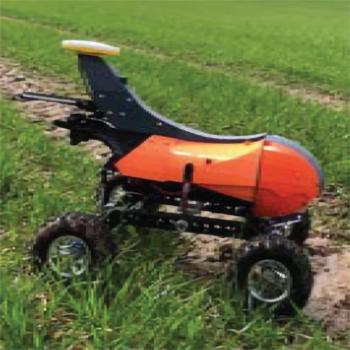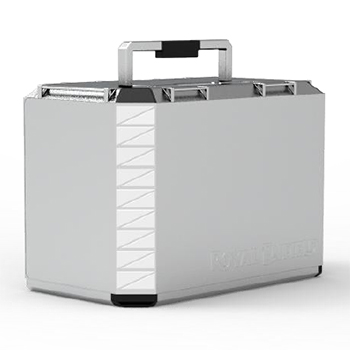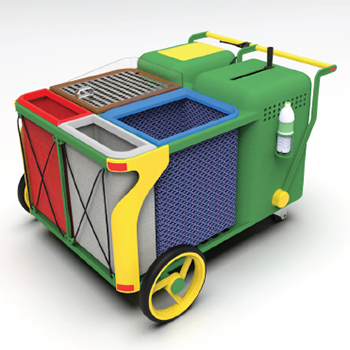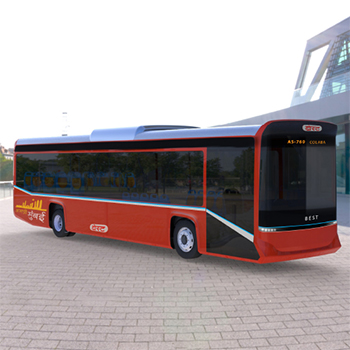Mobility Design
Batch 2017-2019
(39 items)
Mobility DesignBatch 2017-2019
(39 items)
(39 items)
Recent advances in design innovation in mobility and vehicle design
by Anshuman Dixit
by Anshuman Dixit
Public sharing and all other ridesharing organisations fail to answer users needs to ride in a simple, quick, and efficient manner from door to door because the two ends of the route remain problematic. The challenges include not just carrying an individual and moving from one place to another but also the portability of the device in busy places. Following are some examples of the devices that are recently known for the innovative idea used by a single person for last-mile connectivity. These vehicles are different from one another in many ways, not only in the way to ride but also in the type of fuel used and propulsion. The increase in these vehicles is seen in the significant manner which shows the need and interest people have to explore these vehicles. This interest leads to a lot of effects on society, transportation systems, nature and the environment. These vehicles provide a better solution for the problem of last-mile connectivity but not at the cost of environmental issues.
Details >>Design of 12 m boat for Ganges retaining the regional design elements
by Anshuman Dixit
by Anshuman Dixit
For the first time in India, fibre glass houseboats are being introduced by Samudra Shipyard, India’s No. 1 fibre glass boat builders. Having been into boat building for more than 3 decades, Samudra has been introducing lasting technological advantages on an ongoing basis. At present it is the only ISO 9001:2008 certified company in its field of activity. Samudra Shipyard (P) Ltd. designs, manufactures, supplies and services composite (FRP) boats up to 34 m (111 feet) in length for travel, tourism, defence and fishing. We also manufacture water sports equipment, marker buoys and other marine-related products. A preliminary exercise was conducted in the Samudra shipyard to explore and sensitise the boat manufacturing and design workflow. Brainstorming was done with all the interns, and important aspects were taken into consideration, based on which further exploration was done with solid boat-shaped structures (fibreglass). Different shapes and packaging styles were tried out along with scaled-down human mannequins, leading to a substantial amount of ideas and prerequisites in the brainstorming session which was done further.
Details >>Designing interior for a long distance private taxi
by Anshuman Dixit
by Anshuman Dixit
Cars today provide decent comfort and convenience to passengers for them to go places, but when it's about travelling long distances, which could last for more than six to seven hours of continuous sitting in the vehicle, even the expensive cars are not good enough. Passengers face many issues and problems, like compact space to sit for long hours, lack of legroom, restriction of one particular sitting position, insufficient space to efficiently work or relax in a comfortable position, lack of luggage space, and quality and maintenance of cabs. This project aims to address the issues with various kinds of interior design problems occurring because of the conventional design of a personal car which later gets transformed into a taxi.
Details >>Mobility solution for Indian Army in Siachen region
by Anshuman Dixit
by Anshuman Dixit
Over the world’s highest battlefield, military personnel faces a lot of problems while moving in the glacier terrains, apart from Cheetal and Cheetah choppers (only allowed for a very few regions) and HAL Dhruv helicopter ,no other vehicles are able to perform. Siachen Glacier presents a unique set of environmental challenges for the human body. These include low oxygen, partial pressure due to reduced barometric pressure at high altitude (HA), extreme cold, high levels of ultraviolet radiation and low levels of humidity. Add to this the constant threat of enemy action, which requires man and machine to be fighting fit and alert 24/7. The extreme, harsh, cruel, body- and mind-numbing conditions at this height. Here, you are at risk of getting frostbite if your bare skin touches the trigger of your gun for more than 15 seconds. A person’s body cannot acclimatise to conditions over 5400 metres. If you stay at this height for long, you lose weight, stop eating and sleeping, and experience memory loss. Speech starts slurring. In short, the body just begins to collapse. In the last 30 years, over 850 soldiers have been martyred at Siachen.
Details >>Participatory Research with Marginal Indian Farmers to Design Affordable Farm Tools and Equipment
by R. S. Mahesh
by R. S. Mahesh
Agriculture is one of the main sectors in the Indian economy that accounts for 18% of India’s GDP and provides employment to 50% of the country’s workforce. India is the world’s largest producer of pulses, rice, wheat, spices and spice products and holds second rank in total farm outputs. There are various types of farming methods in India depending on farm size, geographical conditions, climatic conditions, etc. In that respect, Indian agriculture is highly dependent on monsoon rainfall. Additionally, different seasonal crops are rotated to increase the fertility of soil. To design affordable farm tools and equipment for marginal farmers, participatory design research through a mediated participatory toolkit was undertaken to gain farmers deeper insights and aspirations. A thorough understanding of current farming practices in the field led to the design of a sensitising kit – a pictorial representation of farming methods throughout the year and a miniaturised farm participatory toolkit. This project attempts to present elicited deeper insights gained from emerging participatory research done with four groups of farmers (four farmers in each group); their farming experience and knowledge towards exploring new farm tools and equipment. This research in the future would help focus design endeavours towards affordable, effective and context-sensitive farming tools and equipment.
Details >>Internship at Tractors and Farm Equipment Limited
by R. S. Mahesh
by R. S. Mahesh
TAFE – Tractors and Farm Equipment Limited, an Indian tractor major incorporated in 1960 at Chennai, with an annual turnover of INR 93 billion (2014-15). The third-largest tractor manufacturer in the world and the second largest in India by volumes, TAFE wields about 25% market share of the Indian tractor industry with a sale of over 150,000 tractors (domestic and international) annually. TAFE's partnership with AGCO Corporation and the Massey Ferguson brand for over 58 years is a stellar example of its commitment to building long-term relationships with its stakeholders through fair and ethical business practices. TAFE is also a significant shareholder in AGCO Corporation, USA – a US $8.3 billion tractor and agricultural equipment manufacturer.
Details >>Design of Compact Vehicle for Nuclear Family
by R. S. Mahesh
by R. S. Mahesh
In India, most of the nuclear families use two-wheelers as their family vehicle. A person driving a two-wheeler in a congested manner in the narrow street and traffic road with his wife on the pillion seat and a kid in front is a most common scene in India. Auto rickshaws are not as comfortable as cars, and cars are too wide for narrow streets. This "two-wheeler" family is slowly moving into the hatchback segment, which increases the traffic density, especially in urban cities, which need to be controlled. Also, riding with more than two people is not safe. This project has addressed those problems and tried to solve this problem by introducing a vehicle between a bike and an auto rickshaw.
Details >>Design of Next Generation Tractor for Young Farmers In India
by R. S. Mahesh
by R. S. Mahesh
Agriculture in India is one of the major sectors of the Indian economy, having 18% of India’s GDP. Farm mechanisation in India has reached 40 to 45%, in which tractors form an integral part of farm mechanisation and have a crucial role to play in increasing agricultural productivity. India is the largest producer of tractors. The technology and the aesthetics in the tractors are getting modern these days. Young farmers in India wanted to perform multiple applications with comfort using tractors and would like to see the tractor as a symbol of their lifestyle. Hence, this project is to design a next-generation tractor for young farmers satisfying their aesthetic aspirations based on the user research with a sample of young farmers in India.
Details >>Products from popular science fiction movies
by Niketh SJ
by Niketh SJ
Science fiction is a genre of fiction which deals with imaginative and futuristic concepts, inclusive of space exploration, advanced science and technology, time travel, extraterrestrial life, etc. It explores how different scientific innovations can affect the world. There were primarily three mediums by which science fiction and its influence grew – books, film and television. Of these three, science fiction films have been the most influential, as they paint a vivid visual imagery of the imaginative worlds which were conceptualised. Although television has a huge influence now, earlier this was not the case. If we look back to the number of sci-fi television shows which came out during the initial boom of sci-fi, it's very little compared to the films that were made. This study deals with the medium of films. Science fiction movies have always portrayed thought-provoking concepts by pushing the limits of human imagination. Movies like Star Trek, Star wars, E.T., Frankenstein, The Time Machine, etc., have all presented the audience with different scenarios of a possible alternate timeline or predicted a very interesting future. These visionary movies are usually visualised through highly imaginative settings, expert film production design, advanced technology gadgets (i.e., robots and spaceships), futuristic scientific developments, or by expertly crafted special effects. It is a genre that utilises predictions which are based on scientific theories but have not yet been accepted nor proven practical by science. These movies tend to explore themes like artificial intelligence, the human condition, survival scenarios, political, social and philosophical issues, etc. The technology and possibilities shown in these movies have turned inspirational in the development of real-world technology and have quite often changed the course of human history. The products showcased in these movies, like the touchscreen interfaces from Minority Report (2002), the wearable smart goggles from Back to the Future II (1989), and the video calls from 2001: A Space Odyssey (1968), have all turned into reality over the course of time. This project tries to collate technology and products that have been used in several popular science fiction movies (between 1950 and 1980) and develop a link between the context which led to its evolution, the product scenario predicted in the movies and the present real-world scenario.
Details >>Design of A Catamaran Based Solar Tourist Boat for Central Institute of Fisheries Technology (Cift)
by Niketh SJ
by Niketh SJ
CIFT had earlier sourced one solar fishing boat from Navgati. This is capable of carrying 4 fishermen and was exclusively used for fishing purposes. The boat has a catamaran-style fibre hull with solar panels mounted on the roof. The boat can be used in reservoirs, small rivers, and aquaculture ponds. This boat also can be used for recreational fishing activities. The boat is capable of running for 2.5 to 3.0 hours after complete charging and attains a speed of nearly 4.0 knots in calm water. Considering the 240 days of fishing in a year, the fuel saved compared to an equivalent diesel-powered boat is Rs. 48,000.
Details >>Designing new experience of next-gen tourist houseboat for Kerala backwaters
by Niketh SJ
by Niketh SJ
The state of Kerala has an extensive network of backwaters which has been used for transport and tourism for decades. An image which pops into our heads when we hear backwater tourism is that of a traditional Kerala houseboat sailing through a serene and rich environment. This calming experience is destroyed by the noise and vibration caused by the diesel engines. Along with this discomfort, it also causes high levels of air and water pollution. This project deals with designing a new experience for houseboat tourists, providing them with an array of luxurious spaces by which they can enjoy the serene scenic beauty without any disturbance and providing an alternative to conventional diesel-powered houseboats. For this purpose, extensive user research was done along with a co-design process to figure out the latent needs of the users. The insights from this exercise led to developing spaces for activities and experiences within the boat. The planning and layout of the boat were inspired by traditional Kerala architecture & art forms. These layouts were evaluated by users on certain criteria, and the most appealing one was further developed. The design features next-gen solar panel and battery systems which are much more efficient than conventional ones, thereby discarding the conventional diesel engine system. An in-depth study of the evolution of houseboats and subsequent form development led to the design of exteriors which drew its inspiration from the festivals and art forms of Kerala.
Details >>Design of a Transformable E-Motorcycle for 2035
by Niketh SJ
by Niketh SJ
Motorcycles have always been associated with the thrill and joy of riding. This experience varies with the type of ride or the segment of motorcycle which is being used. Presently, users have to buy or rent out different motorcycles to have different experiences – the thrill of a high-speed sports bike or the dominance and excitement of an adventure tourer. What if the bike transformed from one segment to the other on the go? What if the ride adjusted itself based on the user requirements? What if selecting different ride modes meant changing the entire geometry of a motorcycle while riding it? This project deals with trying to find solutions for these few questions. A speculative scenario for 2035 was developed after conducting studies on the trends and development of context, technology, products, transportation systems, users & their lifestyle, etc., in the possible future. This led to the generation of a persona and a storyboard which depict the user’s lifestyle and need for the product. The transformable motorcycle was designed as a tailor-made solution for users based on his/her ergonomic needs. A motorcycle which can switch seamlessly from an urban commuter to a racer or an adventure bike with a simple voice command. A design in which the surfaces react to stimuli and vary its geometry to give the user a different feel and experience every time he rides it.
Details >> What Has Always Been More Fun?
by Nipurn Solanki
by Nipurn Solanki
There are a number of games from ancient times that are still being played today through generations. A handful of them, though, have evolved into a more sophisticated version, e.g. Ludo is derived from the Indian game Pachisi from the 4th century. Though the time for playing outdoor games is diminishing and the addiction to the virtual world has brought many of these to the brink of extinction. This study is an attempt to find which are the most popular outdoor games amongst the elderly, middle-aged and youth. The work presented aims to identify the reasons and the commonality of these games, which have kept them fresh and relevant throughout, acknowledging the influence of various external factors.
Details >>Design of a performance brat cafe racer based on Royal Enfield Continental GT500 platform for Rajputana Custom Motorcycles
by Nipurn Solanki
by Nipurn Solanki
Rajputana’s work showcases influence from various aspects of Rajasthan weather, whether it be culture, architecture or art. Weather there has been very harsh, and one has to work hard to put a day's meal on the table. This has made people hard-working and polite at the same time, as this actually reciprocates to finer detailing in their work. Attention to detail is something to look up to. Koftgari, sword making and dagger making are the finest arts found in Rajasthan. The influence of Rajasthani miniature painting is very evident on their motorcycles. RCM collaborates with different artisans who master the craft of koftgari, silver inlay and gold inlay.
Details >>Interior design of a personal autonomous vehicle enhancing interaction and experience
by Nipurn Solanki
by Nipurn Solanki
Autonomous cars, electric mobility and shared mobility services are some of the cutting-edge technologies which offer a great potential to be explored. Any one of these alone would be an interesting development, but all three together is a tectonic shift. Electrification and autonomy will bring new technology which will affect the package and proportions of the cars. Where are we going to place the motors? How are the passengers going to sit? All of that is now open to new interpretation. In the future the unique selling point for cars is going to be the experience that an interior space offers. With autonomy, the notion of comfort will change. In the current scenario, there is a particular seat set up for driving, and the ergonomics are also set up for driving. But, with autonomous vehicles, when the use changes to an environment where people can spread out, relax, or even take a nap, then the environment should adapt accordingly. The project primarily focuses on exploring different such ideas of interiors for a personal autonomous vehicle.
Details >>Design of A Motorcycle Concept for Year 2030
by Nipurn Solanki
by Nipurn Solanki
Design always has been inseparable from the socioeconomic, cultural and technological factors, and therefore automotive styling has been influenced by it in many ways. Motorcycles, unlike their four-wheeled counterparts, had a moderate history of advancements, followed by sudden explosions of innovative engineering excellence. Without a solitary creator who can lay sole claim to being the innovator, it appears that the thought has struck various specialists and designers around Europe at around a similar time in the late 18th century. In spite of the fact that the essential structure continues as before, its appearances, function and the manner in which it has been used have changed drastically. This project focuses on studying trends, which in turn has helped in creating a scenario of the future. The concept electric motorcycle that is going to be designed is based on the predicted scenario and makes use of cutting-edge technology and human factors such as lifestyle and needs in the future. The research phase began with a comprehension of the motorcycle design evolution layered with numerous influencing factors in a chronological manner. Emerging technology and styling trends in the motorcycle industry were identified, and how these developments changed the overall form of motorcycles was also studied through silhouettes. Finally, the user profile was created to culminate the design brief and the subsequent steps, such as the creation of a mood board, ideation, and concept generation, were carried out based on the foundation laid by the research phase.
Details >>History and analysis of vehicle graphics in India
by Onkar Khot
by Onkar Khot
Art and design diversity and heritage in our country are a blend of various cultures in different parts of India. Every state here has different ways of communicating in various mediums like language, literature, art, design, architecture, etc. One of the ways of communication is vehicle graphics. It has been so influential that vehicles like trucks and buses without graphics are rare. Also, people like Cartist are showcasing the Indian art culture through cars and also supporting the artists across the country to showcase their talent. Truck art is the best example of creative graphic work. It replicates the background and identity of the person in a unique way. The body is not made by the OEM; it is handcrafted to fulfil the needs and aspirations of the driver or the owner. The people who make it possible are not art or design graduates; they are people with their own styles developed by a great amount of skill sets. This report includes documentation and analysis of various types of vehicle graphics on various segments of vehicles. Different events in the country, artist contributions in vehicle graphics are studied for graphic style, typography, messages, colours, location, artist, etc., which can be further developed and adopted for more meaningful uses. The possibilities that this project provides are so wide that it is not possible to achieve them in a short time span. Since the graphics on vehicles differ from region to region within a state and also from state to state. So in a broader sense, if all these are to be documented and analysed, it will prove to be a useful exercise.
Details >>Design of front fascia of an electric bus, redesign of a sleeper bus, form exploration and alias surfacing of a bus
by Onkar Khot
by Onkar Khot
'Abhikalp' means 'creation' in Hindi. This ethos forms the basic foundation of Abhikalp Design Studio. An industrial design consultancy based in Indore, India, dealing in all spheres of product design and development. Abhikalp is a team of industrial designers and engineers, experienced in solving clients’ problems at any stage of design. Their commitment to design is to satisfy the client’s requirements satisfactorily.
Details >>Design of an E- shuttle for IIT Bombay
by Onkar Khot
by Onkar Khot
IIT Bombay, a top-ranked educational institute in India, is facing the problem with first-mile and last-mile connectivity. Residents, students and visitors can reach the main gate by public transport, but after entering the campus they don’t have any vehicle to reach home, college or hostel. Also, staff and students who don’t have cycles or personal vehicles face inconvenience because there is no transport solution to reach work or college. They have to wait for an auto rickshaw. Also, at night, it is very difficult to get an auto rickshaw, so they have to walk 2 to 3 kilometres to reach their home or hostel. In the rainy season, the situation is even worse. Due to high demand, chances of getting an auto rickshaw are less. So, the last mile and first mile connectivity problem leads to an increase in the number of ‘personal vehicles’ on the roads of the campus, and this has become a major issue for road congestion and parking space. Rapid growth in the personal vehicles has become the prime reason for air and noise pollution in the campus of IIT Bombay.
Details >>Design of 3 wheeled electric delivery vehicle for Strom Motors
by Onkar Khot
by Onkar Khot
Strom Motors, an electric vehicle start-up company from Mumbai, unveiled an all-new electric car in April 2018 in India. It is a compact, two-door electric vehicle that uses a reverse trike configuration. The promotion of the vehicle is going on, and the initial response of the target customer, which is the urban commuter, is extraordinarily good. Because of the highly positive response and growing e-commerce market in the country, the company planned to design an all-new 3-wheeled, reverse trike-configured electric delivery vehicle on the same platform as R3. About the e-commerce market, India is the fastest-growing market for the e-commerce sector. Being driven by a young demographic profile, increasing internet penetration and relatively better economic performance, India’s e-commerce revenue is expected to jump from US$ 39 billion in 2017 to US$ 120 billion in 2020, growing at an annual rate of 51 per cent, the highest in the world. This supports the proposal to design the all-new electric delivery vehicle.
Details >>How We Live Through Products We Use
by Parthkumar Chaudhari
by Parthkumar Chaudhari
We surround ourselves with different products every day. The choice of the product varies from person to person. This study focuses on documenting those products for different users of the same age group, doing the analysis of the same, and showing how this kind of documentation can be helpful in the field of design, like designing for the future, concept design, or generating a user persona.
Details >>Design of Six Bedroom Houseboat for Varanasi
by Parthkumar Chaudhari
by Parthkumar Chaudhari
Established in 1991, Samudra Shipyard was the first company to introduce fibreglass houseboats. It’s an ISO 9001:2008 certified company that is a pioneer in designing, manufacturing, supplying and servicing composite (FRP) boats up to 34 m (111 feet) in length for travel, tourism, defence, and fishing. It is also in the business of water sports equipment, marker buoys and other marine-related products. The workshop is situated in Aroor, Alappuzha, in Kerala. From the design of the product to the manufacturing of it, it is done here. Before making any product, the design is made, the CAD model is prepared, and after approval of the naval architect, the wooden mould is prepared according to necessity. FRP is sandwiched with resin combined with hardener and then let to dry. A gel coat is applied as a last layer, which gives the part a better look.
Details >>Design of The Delivery Vehicle for Online Grocery Portals
by Parthkumar Chaudhari
by Parthkumar Chaudhari
India’s e-commerce market is growing at a fast rate due to cheap & fast internet availability and penetration of smartphones. Last-mile delivery service is provided by most of the e-commerce platforms, including third-party delivery services like Delhivery and E-Kart, etc. Indian online grocery companies like Grofers and BigBasket are gaining popularity due to the ease of access and fast doorstep delivery. Online grocery portals deliver a wide variety of daily-used products that include perishable items like vegetables, fruits, dairy products, and frozen goods. These items need special care during delivery. At present, order items are packed in cardboard boxes and carried in the canvas bag. Since these bags don’t provide proper cooling and adequate storage, vegetables and fruits often get damaged or seem sufficiently not fresh. These products are returned to the companies, generating a significant amount of waste on a daily basis. This project deals with designing a new delivery vehicle for online grocery portals. For this project, a user study was done by visiting grocery portals such as Grofers and Big Basket to understand the current delivery system, problems faced by the delivery persona, and issues with existing delivery methods. The insights from this exercise led to developing a design brief, which led to the design of new concepts. These concepts were evaluated on specific criteria, and the most suitable one was further developed. The final design is battery-operated, has dedicated compartments for various items, has better ergonomics, provides security for the orders, and eliminates weight carried by the delivery person.
Details >>Mobility Design Intervention for Paddy Cultivation In Small and Marginal Farms of India
by Parthkumar Chaudhari
by Parthkumar Chaudhari
Indian agriculture industries have seen significant growth in the last few decades. Agriculture and allied industries remain first in providing a livelihood to the Indian population. However, due to inheritance land law, the size of operational holdings has kept decreasing. Around 86% of total holdings fall under small and marginal farms. These farms are facing problems such as lack of implementation of new technology, proper marketing of agricultural products, infrastructure, and mobility for agricultural sectors. For generations, small and marginal farmers have been following manual land preparation methods because current machines are not suitable for their operational holdings. Even though India is the world’s largest manufacturer of agricultural machinery, it lags behind in providing a mobility solution for the small and marginal farms. This project aimed to design a new compact agriculture vehicle which can perform various agriculture practices such as ploughing, tilling, puddling, sowing, & harvesting for small and marginal farms. For this project, a user study was conducted by visiting small and marginal farmers in Gujarat and Maharashtra to understand their methods of farming, problems with current agriculture machines, and needs. The design brief was generated based on insights from this study and led to the generation of different concepts which can perform multiple land preparation activities in one go.
Details >>What has always been more fun? (Indoor games)
by Roshan Kumar Sahu
by Roshan Kumar Sahu
There are several games from the age-old ancient times that are still being played through generations. There is a commonality in people’s mindset in choosing these games and commending them for playing on several occasions among the groups of different ages. The study shows the interest and popularity of the games played by grand elders (Gen-1), middle ages or the youth (Gen-2) and the children (Gen-3) and estimates the cause of the fun these games provide to the players to target their interests. This shows a direction to conclude the manner of simplified ancient games that are being played, and the direction of the games that are neglected is identified.
Details >>Design of Eight-Bedroom Houseboat for Varanasi
by Roshan Kumar Sahu
by Roshan Kumar Sahu
Samudra Shipyard (P) Ltd. Established in 1991, Samudra Shipyard (P) Ltd. is India’s No. 1 fibre glass boat building company. It is known for its lasting boat-building technology. Unlike others, Samudra Shipyard designs and manufactures their composite boats up to 34 m in length for travel, tourism, defence and fishing. It also manufactures water sports equipment, marker buoys and other marine-related products. As Samudra is known for its composite boat-building techniques in manufacturing, we got an opportunity to take a closer look at how things are made. There are many ongoing projects like ‘Kopra Vallam’, a day cruiser fire-fighting boat for the Sri Lankan government, and many such other projects. FRP (Fibre Reinforced Plastic) is widely used in manufacturing the boats. They design the boat, then make a mould out of wood which is later used for making the parts. FRP is sandwiched with resin combined with hardener and then let to dry. A gel coat is applied as a last layer, which gives the part a glossy look. Generally to save time and manufacturing costs.
Details >>Motorised Vehicle for Paraplegic
by Roshan Kumar Sahu
by Roshan Kumar Sahu
The abrupt onset of spinal cord injury (SCI) is tragic and has a profound impact on the individuals and their families. In the Indian setup, as in most developing countries, very little is known about the exact incidence of SCI, as there is no national database. In India, approximately 1.5 million people live with SCI. Approximately 20,000 new cases of SCI are added every year, and 60-70% of them are illiterate, poor villagers. The majority of them are males in the age group of 16-30 years, signifying a higher incidence in the young, active and productive population of the society. People suffering from SCI manage to do everyday work without fail. But unfortunately they face lots of problems, and one of them is daily commuting to their workplace. A motorised vehicle is a lifeline; it not only saves time but also provides convenience and freedom to move anywhere. In the current scenario of India, paraplegic persons drive vehicles which are not designed specifically for them. The current design does not fulfil all their needs, and sometimes it creates problems. But with the design enhancement, their problem can be solved. The project would require a case study into the present vehicles for paraplegic persons. Find out all the shortcomings of the available design and rethink a completely new design. The new design will allow the driver a confident and hassle-free ride. Also, it will fulfil all basic requirements, like carrying crutches, wheelchairs, luggage, etc., which can be covered in the device. All this can be compiled into the final product, which would be the design of a motorised vehicle for paraplegics, along with a scale model.
Details >>Designing electric bicycle for college student
by Roshan Kumar Sahu
by Roshan Kumar Sahu
Bicycles are a wonderful means of transportation that helps preserve the environment; they reduce air contamination, ecological footprints, and carbon emissions; they are healthy and very inexpensive. The electrical bicycle, or e-bike, is a traditional bicycle equipped with an electric motor to help with pedalling. They are more economical than fuel-powered cars and motorcycles and cheaper than buying an electric vehicle for the city. Interestingly, in the age of big-buck motor cars, electric bicycles appear to be increasingly adopted as a refreshing alternative because they have several advantages. College students use different modes of transportation to travel within campus. The available options for transport for students are personal bicycles, buses, shared cycles, auto-rickshaws, etc. They have to travel frequently between places within their large college campus. The most convenient mode of transportation for students in many institutions was found to be personal bicycles. The vision for the project is to provide an efficient solution for the mobility of college students from one place to another. The main intent is to research the problems with the existing mode of transportation and solve them to provide an efficient solution. The new design will be an option for students against expensive bicycles.
Details >>Biomimicry in design: Approach towards smart farming technology
by Samyak Khobragade
by Samyak Khobragade
In ancient Greek, bios means life, and mimesis means imitation. Biomimetics, or biomimicry, is the imitation of the models, systems, and elements of nature for the purpose of solving complex human problems. Biomim - icry is not a new concept; in fact, traces of the notion can be found in the past. For example, the rib structure of the Eiffel Tower (1884) was inspired by the human femur (thigh bone), and the Eddystone Lighthouse (1759), located in southern England, was modelled based on the shape of the oak tree. The structure remained intact for almost a century before it required repairs. John George Wood was an English priest in the nineteenth century; he devoted his life to writing about natural history. In 1885 he published Nature’s teachings – Human Invention Anticipated by Nature, in which he drew upon his lifetime of observations to produce a remarkable account of hundreds of human inventions and how they were linked to biological mechanisms. “It is that as existing human inventions have been anticipated by Nature, so it will surely be found that in Nature lie the prototypes of inventions not yet revealed to man. The great discoverers of the future will, therefore, be those who will look to Nature for Art, Science or Mechanics, instead of taking pride in some new invention, and then find that it existed in Nature for countless centuries” (J.G. Wood, 1885) The applications of biomimicry can be divided into four major areas, i.e., shape, surface, structure and production.
Details >>Design of FRP catamaran for river taxi service on Brahamaputra, at Guwahati
by Samyak Khobragade
by Samyak Khobragade
The project was done as a part of an internship at Samudra Shipyard Ltd, based in Kochi, Kerala. Samudra Shipyard specialises in applying Fibreglass Reinforced Plastic (FRP) technologies to build a wide variety of boats and related equipment for different purposes. Having an experience of more than three decades in this field, Samudra has also taken part in a number of collaborative projects with other organisations and the government. The project was done as the preliminary stage of bidding on a tender issued by the Government of Assam: Design, construction, commissioning and supply of FRP catamarans for river taxi service on the Brahmaputra River at Guwahati. It provided an opportunity to learn about the various aspects of water transport and the unique challenges faced while designing solutions for water-based mobility.
Details >>Design of Elephanta ferry service with new experience for tourists
by Samyak Khobragade
by Samyak Khobragade
India has an incredible history, and that history has left its marks in the form of historical places. It is a gateway for us to connect to the past and learn from its glorious heritage. And over the years these historical places have become popular tourist spots. The current ferry service doesn’t contribute to the experience of a historical trip; it just connects the endpoints. The problem is that tourists visit Elephanta, but their experience is not so good because most of them barely know the facts, stories and importance of the sculptures. If this information is provided to them along with a comfortable journey, their experience of the actual trip will become rich. The current ferry service is obsolete in terms of technology and design. It does not have proper seating, wood is still used as the main building material, safety equipment is not accessible and proper sanitation is also missing. The government of Maharashtra has allowed private operators to operate ferry service between the Gateway of India and Elephanta in 2017. So there is an opportunity for this project to have an impact in the real world.
Details >>Design of Charter Yacht Interiors for tourists in Mumbai
by Samyak Khobragade
by Samyak Khobragade
Charter yachting is a vast field on its own, and it is growing rapidly in coastal cities like Mumbai, Panaji and Chennai. Mumbai is the business capital of India, and it is also one of the most popular tourist destinations; hence, a lot of businessmen and tourists pay regular visits to the city. The new trend of chartering a yacht for relaxation or gatherings is becoming popular amongst these national and international tourists. The existing yachts are designed for the purpose of personal ownership; however, significant changes will happen in the design of the yacht if it is designed specifically for the purpose of charter. There is an opportunity to design a yacht for the unique needs and aspirations of the users of Mumbai. To understand the scenario, a research of charter yacht agencies in Mumbai was done, and a qualitative user study was also conducted. The user study involved conversations with reputed people from the charter yacht industry in Mumbai and potential users. After the research, the design brief was created along with the basic exterior package of the yacht. Followed by the ideation process that explored different possible layouts on the designed package. Finally, a storyboard created around the target user for better understanding of the context and scenario, and a physical model of the interiors was created to visualise the spaces and flow.
Details >>Promoting the Use of Helmets through User Centric Design
by Srinag K A
by Srinag K A
India has among the most unsafe roads in the world. In 2015, over 400 people were killed in road accidents every day. In the same year, two-wheeler accidents claimed 36,800 victims and left around 93,400 injured. Numbers that could have been significantly lower if riders had proper helmets. Between the years 2008 and 2020, almost 34 lakh people might die of motorcycle crashes. A figure that can be halved with appropriate measures. “As many as 14 lakh of those fatalities can be avoided with the proper use of safety helmets,” the study says. Since wearing helmets has been made compulsory for both the riders and pillions in most of the Indian cities, a user-centric design approach is needed to understand the consumer needs when it comes to the use of helmets and hence promote the use of helmets not only for two-wheeler riders but also for pillions.
Details >>Design of saddle box for Royal Enfield Himalayan
by Srinag K A
by Srinag K A
Saddlebags were usually used for horse riding. In horse riding, saddlebags sit in various positions, on the back, side, or front of the saddle. Most attach to the saddle by straps and ties. They can be made from various materials. Although leather was the traditional material, it is heavier and requires more maintenance than many modern versions. There are several types: pommel bags (which sit in front of the saddle), traditional paired saddlebags (which lie on the hips of the horse, on either side of the cantle), and assorted smaller bags such as a cantle bag (a small tube-like bag that sits just behind the saddle) or a single small saddlebag that may be carried on the offside (right-hand side) of an English saddle. Pannier-style bags are sometimes fitted over a pack saddle used for packing gear on a horse or other pack animal (often, a mule or donkey) rather than for carrying a rider. In Turkish Anatolia, Iran and Baluchistan, saddlebags are traditionally woven in wool, with a front face decorated with Soumak and a plainer flatwoven back. Slits are left along the opening for a rope to close and secure the bag to the pack animal.
Details >>Design of Interiors of An Autonomous Taxi for 2040
by Srinag K A
by Srinag K A
The increase in the human population and influx of people from the rural to urban areas is leading to congestion of cities. With cities expanding where the suburban areas are becoming part of the cities and the outskirts are turning into cities, the distance between suburban parts and cities is increasing, which in turn increases the time taken to travel. Due to the location of commercial hubs in the city mainland, the high prices of land and rent would force people to live in suburban areas. Lower rent rates and the presence of more space would convert suburban areas into residential areas. Due to a rise in population, congestion on the roads would increase. Since the city centres are commercial hubs to which people travel every day from their homes located in suburban areas for work, the traffic and distance would lead to wastage of time and lead to stress – especially for people who drive. Due to this, they might not get to spend quality time with families. When they have to spend quality time with the family members during the weekends by going to places of interest, recreational places such as parks, etc., the family members again have to drive. This again would be stressful to them, and the family time would be taken away due to traffic. This project aims to design the interiors of a taxi for the year 2040. The existence of autonomous taxis in urban areas in 2040 was one of the reasons for choosing this particular year. The interiors must be designed such that the experience of joy and fun of a family travelling together.
Details >>Design of Push Cart for Municipal Solid Waste Collection In Residential Areas
by Srinag K A
by Srinag K A
India produces around 62 million tonnes of garbage every year, and 62% of it ends up in landfills. Since most of the disposed waste is recyclable, it is necessary for the waste to stay segregated till the recycling stage. Unsegregated waste makes it difficult to derive value out of it during the recycling process, as waste gets mixed in large quantities during the collection process. Therefore, the problem must be solved at the roots of waste collection and handling in order to prevent the mixing of waste. The pushcarts used by the pourakarnikas (household garbage collectors) of Bengaluru are the first mediums for the collection and transfer of waste. Through observation, it was noticed that the cart neither aids the process of carrying segregated waste nor is it easy to handle in terms of moving it, stopping it, etc. To understand more problems associated with the cart and see it in the perspective of waste management, field studies were conducted in and outside IIT campus. The studies include understanding the way waste is disposed of by the consumers, the identification and handling of waste by the collectors, and the transferring of the waste and the equipment used to transfer it from the source to the disposal unit. Studies also understand recycling and disposal of waste based on its type. Based on the study, the design brief was structured, and ideation was done. The ideation included creating scaled mock-ups to get a clear understanding of the concept. The agenda during ideation was not only to address the issue but also to make sure that the cart fits into the system. A 1:4 scale mock-up model was created to get a better idea of the design of the cart. And addresses all the issues mentioned in the brief.
Details >>SKATOCROSS- Indias’s first Skatebike in collaboration with VIVRT Motors
by Sunil
by Sunil
The Skatocross concept emerged from the thought of having both a skateboard and a motorcycle. SKATOCROSS will be designed to be a new kind of integrated vehicle. The idea is to provide personal mobility for an individual and to establish a new kind of sport. For steering, users must rely on their own skill and the ability to lean for manoeuvring from one place to another; by implementing Gyro, the skill needed to steer can be eliminated.
Details >>Micro Car for Youth and Couples In India
by Sunil
by Sunil
It is common for youth in middle-class families to demand a two-wheeler from their parents when they start going to college. Parents who cannot afford to give their children a four-wheeler then reluctantly buy them a two-wheeler. They are constantly worried about their children’s safety on the road. The time span in between, when a youth starts to go to college and when he gets married and has his first child, is usually 10-15 years. He usually rides a two-wheeler in this time span till he can afford a four-wheeler. The project is about designing a micro car for youth and couples that can bridge the gap between parents perception regarding small car safety. Final design gives the essence of the perceived safety of the vehicle through its overall form and volume. There is a need in the Indian market for a perceived safe, unisex, micro car for such users.
Details >>Design of Next-Generation AC City Bus for BEST Mumbai Transport
by Sunil
by Sunil
The Brihanmumbai Electricity Supply and Transport (BEST) is a civic transport and electricity provider in Mumbai. The story of BEST starts in 1873 as a tramway company called “Bombay Tramway Company Limited”. The company set up a captive thermal power station in 1905 to generate electricity for its trams and also supply electricity to the city. Their company rebranded itself to “Bombay Electric Supply & Tramways (BEST)” Company. In 1926 BEST also becomes the operator of motor buses. In 1947, the BEST became an undertaking of the Municipal Corporation and rebranded itself to “Bombay Electric Supply & Transport (BEST)”. In 1995, as Bombay was being renamed to Mumbai, then the organisation was renamed to “Brihanmumbai Electric Supply & Transport (BEST)“. In addition to buses, BEST also provides ferry service in the northern reaches of the city.
Details >>